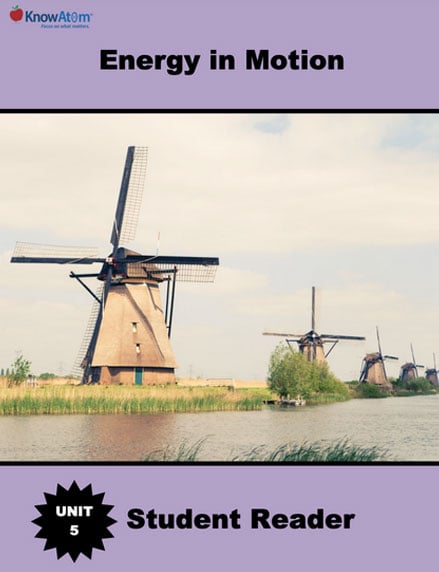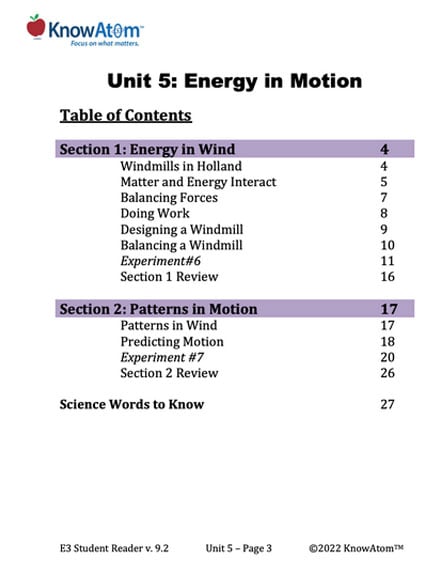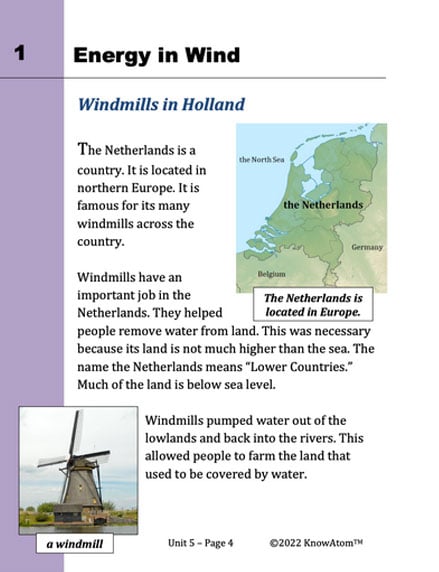In this lesson, students build model windmills to observe the transfer of energy and then carry out an experiment to test how windmill blades in balanced and unbalanced positions affect the amount of marbles a windmill can lift.
In this unit, students bring together what they have learned about the interactions of energy and matter to explore the science phenomena of relationships between energy, force, and motion. In this lesson, they investigate how windmills transfer the kinetic energy in wind so that it can be used to do work, and then use that knowledge to analyze balanced and unbalanced forces. This page showcases key components of this lesson.
The science background gives teachers more in-depth information about the phenomena students explore in this unit. Below is an excerpt from the background information on windmill forces.
Wind has energy because it is moving air molecules. As cold air sinks in the atmosphere and warm air rises, it creates wind. Remember that energy is the ability to do work. Work is any change in position, speed, or state of matter due to force. Unlike matter, energy is not made up of atoms. However, matter and energy are constantly interacting. In the same way that all organisms need energy to survive, grow, and reproduce, matter can only change when enough energy is present.
There are different forms of energy, which is never created or destroyed. Instead, it transforms from one form to another. Energy is always either being stored or doing work. Energy that is stored is called potential energy. For example, all matter has a form of potential energy called chemical energy. This energy is stored in the bonds of atoms and molecules. The reason we eat food is because food contains chemical energy. This chemical energy was once light energy from the sun. Plants and other producers capture the sun’s energy and during photosynthesis, turn it into chemical energy stored in glucose, which living things need to survive.
Energy of motion is called kinetic energy. The more kinetic energy something has, the more work it can do.
Windmills are able to pump water in the Netherlands because windmills are structures that capture the wind’s kinetic energy to do work. This is possible because wind produces a force when it hits the windmill’s blades. Remember that a force is a push or pull that acts on an object, changing its speed, direction, or shape.
Without force, nothing can move. When all of the forces acting on an object are balanced, the object will not change its motion. Balanced means that all of the forces acting on an object are equal. Unbalanced means that the forces acting on an object are not equal. If you want to change an object’s movement, there has to be an unbalanced force acting on it. An unbalanced force can change the speed or direction of the object. Wind provides the unbalanced force that moves the windmill’s blades.
When the force of the wind hits the windmill’s blades, the force transfers some of the wind’s kinetic energy to the blades. When energy is transferred, it moves into or out of an object or system. This transfer of energy causes the blades to turn powering a pump.
In this lesson, students build model windmills to observe the transfer of energy and then carry out an experiment to test how windmill blades in balanced and unbalanced positions affect the amount of marbles a windmill can lift.

Prepared hands-on materials, full year grade-specific curriculum, and personalized live professional development designed to support mastery of current state science standards.
Misconception: If an object is at rest, there are no forces acting on it.
Fact: There are forces everywhere. When an object is at rest, all of the forces acting on it are balanced.
Misconception: A force is necessary to keep an object moving.
Fact: An unbalanced force changes an object’s motion. An object that is already in motion will continue moving until acted on by an unbalanced force, such as friction.
Misconception: Only moving objects have energy.
Fact: Nonmoving objects have stored potential energy.
Balanced : when all of the forces acting on an object are equal
Friction : a force that slows motion whenever two objects rub against each other
Kinetic Energy: energy of motion
Potential Energy : energy that is stored
Unbalanced : when the forces acting on an object are not equal
Wind : moving air molecules
Windmill : a structure that captures the wind’s kinetic energy to do work
Work : any change in position, speed, or state of matter due to force

Windmills in Holland
The Netherlands is a country. It is located in northern Europe. It is famous for its many windmills across the country.
Windmills have an important job in the Netherlands. They helped people remove water from land. This was necessary because its land is not much higher than the sea. The name the Netherlands means “Lower Countries.” Much of the land is below sea level.
Windmills pumped water out of the lowlands and back into the rivers. This allowed people to farm the land that used to be covered by water.
Matter and Energy Interact
Windmills pump water because they capture the energy in wind. Wind has energy because it is moving air molecules. When air gets cooler, it begins to sink downward. When air warms up, it rises. This motion creates wind.
Energy is the ability to do work. Work is any change in position, speed, or state of matter due to force. Unlike matter, energy is not made up of atoms. However, matter and energy are always interacting. Matter can only change when enough energy is present.
There are different forms of energy. Energy can change from one form to another.
Potential energy is energy that is stored. For example, all matter has a form of potential energy called chemical energy. This energy is stored in atoms and molecules. We eat food because food has chemical energy. Our bodies need that chemical energy to survive.
Kinetic energy is the energy of motion. The more kinetic energy something has, the more work it can do. When the wind blows, it has kinetic energy.


Balancing Forces
Windmills pump water in the Netherlands because they capture the wind’s kinetic energy to do work. This is possible because wind produces a force when it hits the windmill’s blades. Remember that a force is a push or pull that acts on an object, changing its speed, direction, or shape.
Without force, nothing can move. When all of the forces acting on an object are balanced, the object will not change its motion. Balanced means that all of the forces acting on an object are equal. Unbalanced means that the forces acting on an object are not equal.
If you want to change an object’s movement, there has to be an unbalanced force acting on it. An unbalanced force can change the speed or direction of the object. Wind provides the unbalanced force that moves the windmill’s blades.
For the hands-on activity in this lesson, students design windmills and develop a question to investigate how balanced versus unbalanced forces affect how many marbles the windmill can lift. Students compare the maximum number of marbles the windmill can lift with different numbers of windmill blades in balanced and then unbalanced positions. Students use their data from the experiment to explain how the motion of an object is affected by balanced versus unbalanced forces. Students present their conclusions and compare results with other student teams, evaluating reasons for possible differences.
KnowAtom incorporates formative and summative assessments designed to make students thinking visible for deeper student-centered learning.
.png?width=308&height=415&name=Screenshot%20(19).png)
Standards citation: NGSS Lead States. 2013. Next Generation Science Standards: For States, By States. Washington, DC: The National Academies Press. Neither WestEd nor the lead states and partners that developed the Next Generation Science Standards were involved in the production of this product, and do not endorse it.